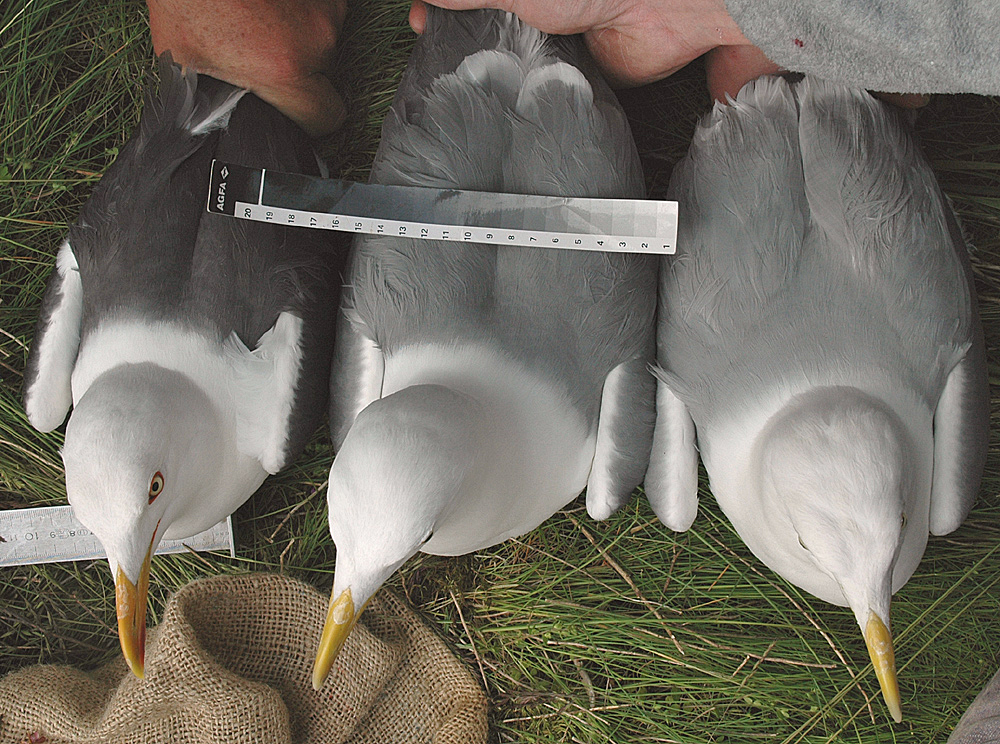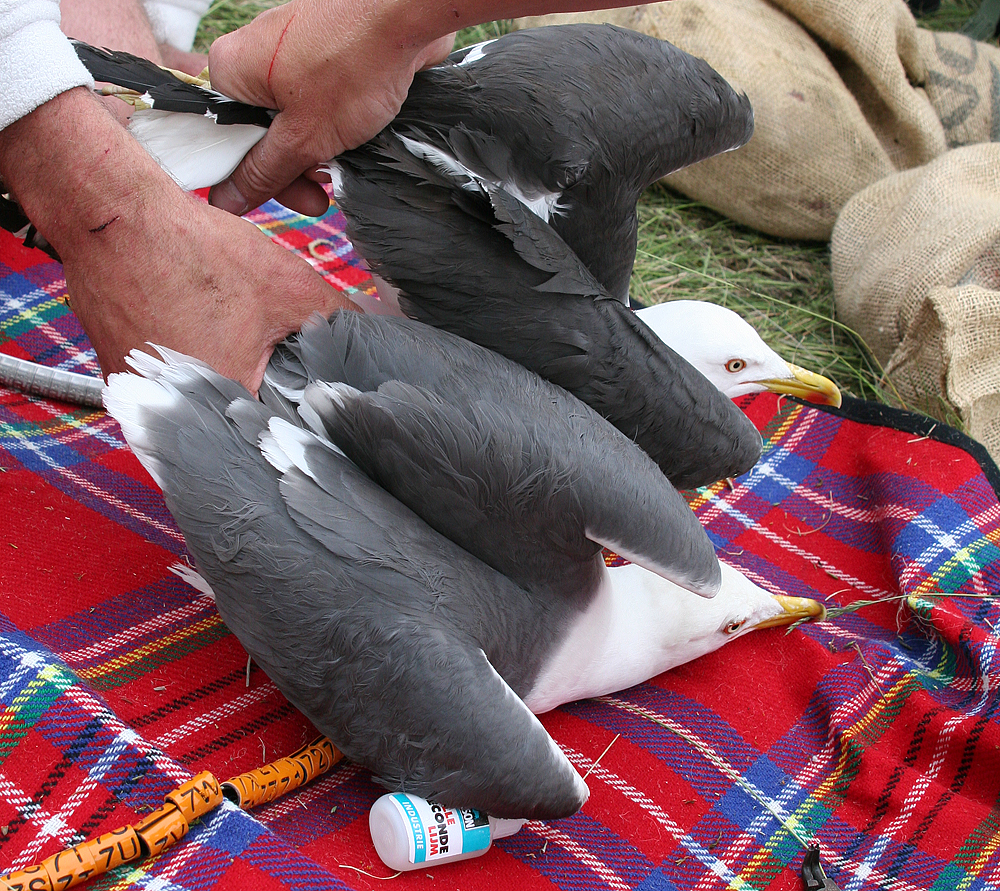 Heuglin's Gull (L. heuglini / antelius)
Heuglin's Gull (L. heuglini / antelius)
(last update:
Upperpart grey-tone.
In May 2005 we caught 742 breeding birds within 6 days and in 2006 we caught 764 birds in a mixed colony of Herring and Lesser Black-backed Gulls at Moerdijk, the Netherlands. We obtained the following data:
| Darvic code / metal ring | in the field |
| Species | in the field |
| Sex | in the field |
| Wing-span | in the field |
| Tarsus / Head (when necessary) | in the field |
| Grey-tone | in the field + Photoshop grey mode |
| P10 pattern | from photo’s |
| P10 division | from photo’s |
| P9 pattern | from photo’s |
| P5 pattern | from photo’s |
| Black on Bill | in Photoshop |
| Red on Bill | in Photoshop |
| Pigmentation of the iris | from photo’s |
| Orbital ring | in Photoshop |
This webpage gives the results for upperpart grey-tone of these breeding birds. For details on colour scales, see also: GENERAL NOTES ON GREY TONES AND COLOUR CHARTS.
The graph above illustrates that there was no overlap between Herring and Lesser Black-backed Gulls in their upperpart tone. The modal (most frequent) grey tone of the Herring Gulls sampled was 5 (range 3-7) while that for the Lesser Black backed Gulls was 11 (range 8-15), based on samples for Herring Gull (n = 292) and Lesser Black-backed Gull (n = 888).
The two images below illustrate the upperpart tones of both species and a hybrid. The next image is dark Lesser Black-backed Gull oLP with grey tone 15, together with an individual showing the most frequent grey tone of birds breeding in the colony (grey tone 11).
Upperpart grey-tone is the prime characteristic for separating graellsii, intermedius and fuscus Lesser Black-backed Gulls (Barth 1968). The Moerdijk birds ranged from Kodak 8 to 15, the modal grey tone of 11 being close to the population mean of 11.7 for intermedius from southwest Sweden (Barth 1975) and clearly darker than British graellsii (Barth 1975: Munsell 3.3 or higher; Howell & Dunn 2007: Kodak 9-11; Malling Olsen & Larsson 2004: Kodak 8- 10). This magnitude of variation at Moerdijk is clearly visible in the field, without quantitative assessment using scales (see images below).
Could these darker upperparts in Dutch birds be a result of recruitment from southwest Scandinavia? Despite intensive ringing programmes in southern Norway and southwest Sweden, genuine intermedius has only very rarely been found breeding in the Netherlands in the past 20 years (N. van Swelm, F. Cottaar & K. Camphuysen pers. comm.). Ring recoveries show that it is the paler British graellsii that can be found breeding annually (although in small numbers) in several Dutch colonies. Nominate fuscus from the heartland of its range (southwest Finland and northeast Sweden) shows grey tones of 13-17 (mean 14.4) (Barth 1968; Jonsson 1998b). In our Dutch sample, six birds out of 888 (0.7%) showed grey tones of 14.5 or 15.0, matching average nominate fuscus in the darkness of the upperparts. The dark upperparts of some Dutch birds may be an historic influence from the first colonists, which may have originated from Scandinavia (colonisation started in the north of the country, on Terschelling in 1926; Teixeira 1979).

Breeding gulls, Moerdijk, the Netherlands: grey tone 11 in LBBG oJH (left), grey tone 8.5 in 14cy hybrid m35 (centre, ringed pullus green EV65 at Dintelhaven-Maasvlakte in 1992) & grey tone 6.0 in HG m36 (right).

Breeding Lesser Black-backed Gulls, Moerdijk, the Netherlands: grey tone Kodak 11 in o31 (average) and Kodak 15 in oLP (dark).
Barth (1968, 1975) has plotted Munsell values for both species (see EXCEL SHEET). These data were converted to the Kodak Grey Scale by Jonsson (1998). Nominate fuscus from the heartland of its range (SW Finland & NE Sweden) shows grey tones of 13-17 (mean value 14.4). In our Dutch sample, 10% (92 individuals) showed grey tone 13.0 or higher and therefore match pale to average nominate fuscus in the darkness of their upperparts. The modal grey tone among the Moerdijk Lesser Black-backed Gulls is close to the population mean of 11.7 for intermedius from the Swedish SW coast given by (Barth (1975). Recent research and a publication by Andreas Noeske showed similar results for the island Amrum, N Germany.
Below, you can find a map with clustered column charts for Scandinavian location. The aggregate stacked charts, categorized per sub-species can be found by clicking the map. Illustration based on E. K. Barth: The circumpolar systematics of Larus argentatus and Larus fuscus with special reference to the Norwegian populations, IN: Contribution No. 86, Zoological Museum, University of Oslo. You can click all charts to get a larger image.
